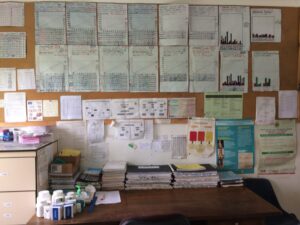Creating Standards for Health Services – CPR (Community Based, Processes, Results)
Download the Anatomy of a Health System
Hello, welcome to Realizing Global Health. This is Dr. Elvira Beracochea. I am the founder, CEO and president of Realizing Global Health. We are a global health consultant company where we help clients develop self-reliant, sustainable health systems that deliver quality healthcare to everyone everywhere every day—these three keywords are very important to us because it sets the standard for how we work in global health.
Today, we are going to talk about standards and how we make sure that we are actually delivering quality healthcare for everyone everywhere every day. We talked about the health system. We talked about how health programs work. Now we are going to talk about how the health facility (clinics, hospitals, etc.) work to make sure they deliver quality healthcare for everyone everywhere every day. That is because they have to meet three important principles. These principals make up C.P.R. – community-based, written processes, and they have to be accountable for results.
Let’s talk about the first one, community-based. What does that mean? When we deliver health services, the health programs we talked about need to be translated into services that are provided through health centers, hospitals, clinics – public and private, etc. What we mean is that the community where they are and the people that they service becomes their client base. We call this the denominator, the cover area, the local population. That population has specific needs that may differ from the specific needs of other areas. So it important that we understand the needs of our community. When we translate what the program says that quality health care has to be- that we combine that with packages of services that meet the local needs and are community-based.
Second, there have to be processes. To make sure that we don’t forget anything and that we fulfil all the different programs that our clients need, we have to have processes in place that meet quality standards, are efficient and consistent– so that we really serve everyone everywhere every day. The goal is that everyone receives the same quality of healthcare no matter where the health facility is located within the country.
Finally, we talked about results. We talked about the community-based approach to understand the needs of the community. What are the results? Are our programs and services really making a difference? We have to really measure how well we are doing? We need to measure the numerator. The population becomes the denominator and what we do is the numerator. This allows us to calculate rates and ratios that allow us to measure how well we are working. A health facility is not able to measure how well they are doing if they don’t have the right information. Its’ like playing soccer without knowing if the ball made it in the goal or not. We have to make sure we meet those three standards of community-based, efficient processes and we really get the results. Remember C.P.R.
Next week, we are going to be talking more about how health providers can work to make sure they meet the standards and how they actually fulfil C.P.R. We will also talk about how we can support them as global health professionals, to do better, save more lives and make a bigger impact—and really fulfil the right to health of everyone everywhere every day. See you next time!


